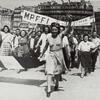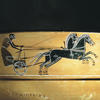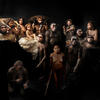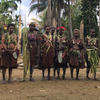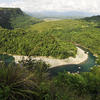You are here
A 300,000-year melting pot

It is unprecedented for prehistorians and ‘specialists of the present’ (sociologists, demographers, etc.) to join forces on a topic like migration. What was the motivation behind this collaboration?
Christine Verna1 and Sylvie Mazzella2: Men and women have always moved around, even in settled societies. It’s common knowledge: all living organisms disperse. However, of all the species, sapiens is unique for having occupied every continent. The arc of history shows that humans have always migrated, in every era and in all directions. Why? Were the motivations different in the past? Can we trace a common destiny between prehistoric and today’s migrations, given their relative acceleration over the past 30 years in a globalised environment?
The concept of the ‘melting pot’, whether genetic or in terms of ideas, know-how and techniques, is essential for understanding the development of the human species, just as on the scale of living things this dynamic phenomenon is essential to life. These converging scientific viewpoints make it possible to emphasise the all too often overlooked interrelation between humankind and nature. As they migrate, humans take a little of their environment with them. When they arrive in a new host region, they change it and are changed by it. This is true of both prehistoric times and the present day. Bringing together the natural sciences, the humanities and the social sciences, past and present, enables us to highlight this aspect.
More precisely, what kind of parallels can be drawn between past and current migrations?
S. M.: The oldest myths that we know, like the Odyssey or the epic of Gilgamesh, already evince a desire to travel, to discover what lies beyond the mountain or across the sea, and in the process, to discover oneself. But it goes further than that. One of the contributors to the exhibition, the historian Julien d’Huy, shows that these myths were undoubtedly disseminated at the same time as the first sapiens. For example, there are stories very similar to the famous myth of Odysseus throughout the Northern Hemisphere, from the Old World to the New World – in particular the tale of the eternal traveller imprisoned by a cyclops in a cave from which he escapes by trickery, hiding under a sheep.

When they migrate, people take along their stories and beliefs, and a whole mystique about travel that helps encourage the subsequent generations to embark on their own journeys. Even today, not all migrations are due to economic, political or environmental instability – individual motives must also be taken into account.
C. V.: There’s a continuity between migrational movements of the past and today. As a palaeoanthropologist, I often explain that the image of linear movement from point A to point B is a misconception. People moved gradually, in multiple phases and sometimes in several directions, with ‘separations’, pauses and backtracking. Working with sociologists like Sylvie Mazzella, I discovered that this is also true of many modern-day migrations. They are far from linear, and the great majority of them take place within a single continent. The idea that it’s always a journey from a poor country to a rich one is also false. Migrations are made up of comings and goings, in more or less lengthy stages, by choice or by necessity, etc.
The exhibition also emphasises the importance of the intermixing of populations and cultures…
C. V.: The encounters between human groups induced by migrations have always resulted in interbreeding, in intermingling that have shaped who we are today as populations and societies. This intermixing contributes to diversity, whether biological or cultural. Contrary to what some people maintain, we are not going to end up all looking alike! In the exhibition, the population geneticist Paul Verdu3 shows that the world’s genetic diversity today originates from that of an ancient population of African Homo sapiens, and Africa displays by far the greatest genetic diversity between populations – much more so than between two Eurasian populations, for example.

S. M.: When individuals leave their habitat, they create pathways, so to speak, bridges between their original environment and their points of arrival. They bring with them knowledge, culture and technical skills, and take back new goods and information when they return. In sociology we call this ‘migratory capital’ and ‘mobility know-how’. Migratory capital comprises a set of resources (economic, linguistic, cultural, etc.), which explains why it is not the poorest people who leave. It also includes know-how from the travel experience itself. While working on this exhibition, I was amazed to discover how important networks have always been. That said, there are also differences. In the past, going far away meant travelling for a very long time and losing touch with one’s family. Today you can cross the whole planet in a few days while staying connected with your loved ones.
More generally, what are the most important differences between prehistory and the present day?
C. V.: Many migrants now move for economic, political or even ecological reasons. Similarly, prehistoric groups could of course migrate because their resources were dwindling, or to expand their territory, or because they were facing significant climate change. But this parallel has its limits. In general, we avoid referring to ‘migrations’ in prehistory when it comes to species – it’s a dispersal, a geographical extension of occupied territories, which took place step by step, from one generation to another.
S. M.: Another key point is that we have much better knowledge of the international migrations of the last 30 years than those of the past. We can define an extremely precise sociological portrait of the people involved, meeting them and interviewing them to understand their motivations and find out what they’ve experienced, sometimes risking their lives – the Mediterranean crossing has become the deadliest migrant route in the world.

We now know that migrations are characterised less by their scope than by their great diversification. All social classes and age groups are concerned; there are more and more women, skilled workers and unaccompanied minors. The number of people fleeing persecution has tripled in ten years. Internal or regional displacements now outnumber international ones. As for the reasons for leaving home (economic, political, family-related, educational, environmental, etc.), they are becoming particularly difficult to disentangle. It’s often a combination of several factors. We made an effort in the exhibition not to simplify, but rather to show the complexity of the situation.
The exhibition also includes personal accounts, imaginative installations and works of art. What do these departures from a strictly scientific approach tell us?
C. V.: It’s a way to put the focus on people. Numbers, scientific data and expertise are important, but migration is also a sensory and emotional human experience. In the ‘e-migrant’ section of the exhibition, for example, visitors can listen to personal accounts on a set of smartphones plugged in around a table. This installation by the artist Séverine Sajous reflects the fact that these phones have become a major tool in this type of displacement. They are a compass, a guide, a source of information, and of course enable the user to send and receive news. Sitting at the table listening to what these people have experienced, we spontaneously imagine ourselves in their place and that of their loved ones. It’s another way, more personal and emotional, to understand what migration really means.
S. M.: The digital revolution has radically altered the everyday life of migrants. On the one hand, it changes their long-distance social relations, allowing them to be both here and there, and in particular to form a ‘transnational family’. On the other hand, this technological breakthrough has also made it possible to tighten border controls and implement stricter immigration security policies, for example by creating biometric passports and dematerialised control data that can be exchanged instantly between governments, not to mention the use of drones and infrared radar systems. Through poignant personal accounts, Séverine Sajous's installation puts this revolution into perspective.

The reality of migration is the subject of political debate. What is the exhibition’s position in this context?
C. V.: Insofar as possible, it offers a neutral scientific perspective on the topic. What are the facts that seem best established today, based on the evidence and decades of research at our disposal? At the same time, what are the questions that remain unanswered, difficult to resolve or insufficiently explored? For all that, of course, the scientific work is not immune to the context. We are all influenced by the debates that affect society. And we cannot stand idly by when so much false information is going around, which is why the exhibition is strongly committed to challenging preconceived ideas.

S. M.: For example, there is an entire section on the maps and statistical data normally used to represent migrations. It illustrates how the same phenomena can be shown in very different ways, and the importance of always exercising critical judgment. Take the widespread idea that a population from the Southern Hemisphere is invading or replacing the population of the wealthier countries. Did you know that only 4% of the people in the world live for more than one year in a country other than the one they were born in? According to the United Nations’ definition, this represents 325 million individuals out of 8.2 billion, spread out over the entire planet…
Moreover, the majority of these are ‘South-South’ migrations, contrary to what many might say. In Africa, for example, 80% of the international displacements take place within the continent. The reality is thus more complex than is commonly imagined. However, the exhibition strives not to portray scientists as ‘patronising’. It presents reliable research findings and paves the way for many debates.
Exhibition: Migrations, une Odyssée Humaine (“Migrations, a Human Odyssey”), through 8 June, 2025 at the Musée de l’Homme, 17 Place du Trocadéro, Paris.
For further reading: Migrations, une Odyssée Humaine, catalogue, edited by S. Mazzella et C. Verna, MNHN editions, 228 pages, €34 (in French).
- 1. A palaeoanthropologist and director of the HNHP laboratory (Histoire Naturelle des Humanités Préhistoriques – CNRS / MNHN / Université de Perpignan Via Domitia), Christine Verna studies the major movements of human populations throughout prehistory.
- 2. A research professor at MESOPOLHIS (Centre Méditerranéen de Sociologie, de Science Politique et d’Histoire – CNRS / Aix-Marseille Université / Sciences-Po Aix-en-Provence), Sylvie Mazzella specialises in modern-day migrations and the related political issues.
- 3. Deputy director of the EA (Eco-Anthropologie) laboratory (CNRS / MNHN).
Author
Fabien Trécourt graduated from the Lille School of Journalism. He currently works in France for both specialized and mainstream media, including Sciences humaines, Le Monde des religions, Ça m’intéresse, Histoire or Management.














